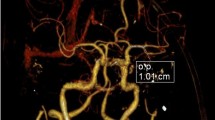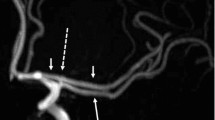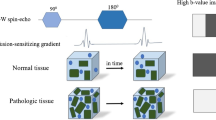Abstract
Background
Moyamoya disease is one of the primary causes of pediatric ischemic stroke, especially in East Asia. Areas of high signal intensity on diffusion weighted imaging (DWI) with decreased apparent diffusion coefficient (ADC) values usually point to irreversible ischemic damage. Reversibility of these DWI hyperintensities during the acute phase of ischemic stroke in pediatric moyamoya disease has not previously been reported.
Case report
A 3-year-old girl was admitted to our emergency department due to sudden onset speech impairment and right hemiplegia. Computed tomography (CT) revealed a multilobal low-density area in the left cerebral hemisphere. The area was hyperintense on DWI with decreased ADC values. Magnetic resonance (MR) angiography revealed stenosis of the bilateral internal carotid artery bifurcations and their branches. Acute cerebral infarction due to moyamoya disease was diagnosed. MR images taken 4 days later showed resolution of most of the DWI hyperintensity areas. The initial decline in the ADC of the reversible DWI hyperintensities was less severe compared to the irreversible lesion. Within several days after onset, the patient became ambulatory although the follow-up MR fluid attenuated inversion recovery (FLAIR) images taken 2 weeks after onset revealed thinning of the corresponding cortical gyri.
Conclusion
These findings indicate that a wide area of DWI hyperintensity during the acute phase of ischemic stroke can be reversed by appropriate treatment in pediatric moyamoya disease. To the best of our knowledge, this is the first report of reversible DWI hyperintensities over a wide cortical area during the acute phase of ischemic stroke in pediatric moyamoya disease.





Similar content being viewed by others
Abbreviations
- ADC:
-
Apparent diffusion coefficient
- CT:
-
Computed tomography
- DWI:
-
Diffusion weighted imaging
- MRI:
-
Magnetic resonance imaging
- ROI:
-
Region of interest
- TIA:
-
Transient ischemic attack
- FLAIR:
-
Fluid attenuated inversion recovery
References
Albach FN, Brunecker P, Usnich T, Villringer K, Ebinger M, Fiebach JB, Nolte CH (2013) Complete early reversal of diffusion-weighted imaging hyperintensities after ischemic stroke is mainly limited to small embolic lesions. Stroke 44:1043–1048
Albers GW (1998) Diffusion-weighted MRI for evaluation of acute stroke. Neurology 51(Suppl 3):S47–S49
Arakawa S, Wright PM, Koga M, Phan TG, Reutens DC, Lim I, Gunawan MR, Ma H, Perera N, Ly J, Zavala J, Fitt G, Donnan GA (2006) Ischemic thresholds for gray and white matter: a diffusion and perfusion magnetic resonance study. Stroke 37:1211–1216
Cho HJ, Jung YH, Kim YD, Nam HS, Kim DS, Heo JH (2011) The different infarct patterns between adulthood-onset and childhood-onset moyamoya disease. J Neurol Neurosurg Psychiatry 82:38–40
Doelken M, Lanz S, Rennert J, Alibek S, Richter G, Doerfler A (2007) Differentiation of cytotoxic and vasogenic edema in a patient with reversible posterior leukoencephalopathy syndrome using diffusion-weighted MRI. Diagn Interv Radiol 13:125–128
Forbes KP, Pipe JG, Bird R (2000) Neonatal hypoxic-ischemic encephalopathy: detection with diffusion-weighted MR imaging. AJNR Am J Neuroradiol 21:1490–1496
Kuroda S, Houkin K (2008) Moyamoya disease: current concepts and future perspectives. Lancet Neurol 7:1056–1066
Labeyrie MA, Turc G, Hess A, Hervo P, Mas JL, Meder JF, Baron JC, Touzé E, Oppenheim C (2012) Diffusion lesion reversal after thrombolysis: a MR correlate of early neurological improvement. Stroke 43:2986–2991
Lecouvet FE, Duprez TP, Raymackers JM, Peeters A, Cosnard G (1999) Resolution of early diffusion-weighted and FLAIR MRI abnormalities in a patient with TIA. Neurology 52:1085–1087
Oppenheim C, Grandin C, Samson Y, Smith A, Duprez T, Marsault C, Cosnard G (2001) Is there an apparent diffusion coefficient threshold in predicting tissue viability in hyperacute stroke? Stroke 32:2486–2491
Peters JM, Maclean AV, Young GS (2010) Rapid resolution of diffusion weighted MRI abnormality in a patient with a stuttering stroke. BMJ Case Rep. doi:10.1136/bcr.07.2009.2063
Rafay MF, Armstrong D, Dirks P, MacGregor DL, deVeber G (2015) Patterns of cerebral ischemia in children with moyamoya. Pediatr Neurol 52:65–72
Schellinger PD, Fiebach JB, Jansen O, Ringleb PA, Mohr A, Steiner T, Heiland S, Schwab S, Pohlers O, Ryssel H, Orakcioglu B, Sartor K, Hacke W (2001) Stroke magnetic resonance imaging within 6 hours after onset of hyperacute cerebral ischemia. Ann Neurol 49:460–469
Takanashi J (2011) Moyamoya disease in children. Brain and Development 33:229–234
Terasawa Y, Iguchi Y, Kimura K, Kobayashi K, Aoki J, Shibazaki K (2008) Reversible diffusion-weighted lesion in a TIA patient without arterial recanalization: a case report. J Neurol Sci 272:183–185
Winbeck K, Bruckmaier K, Etgen T, von Einsiedel HG, Röttinger M, Sander D (2004) Transient ischemic attack and stroke can be differentiated by analyzing early diffusion-weighted imaging signal intensity changes. Stroke 35:1095–1099
Yang Q, Tress BM, Barber PA, Desmond PM, Darby DG, Gerraty RP, Li T, Davis SM (1999) Serial study of apparent diffusion coefficient and anisotropy in patients with acute stroke. Stroke 30:2382–2390
Acknowledgments
We thank Mr. James Robert Valera for his editorial assistance with the manuscript. We also thank Dr. Takeshi Funaki of the University of Kyoto for providing the follow-up MR images.
Author contributions
Author contribution to the study and manuscript preparation include the following—conception and design: all authors; acquisition of data: Tamura and Ihara; analysis and interpretation of data: all authors; drafting of the article: Tamura; critical revision of the article: Tamura and Morota; review of the submitted version of the manuscript: Tamura; approval of the final version of the paper on behalf of all authors: Tamura; statistical analysis: Tamura; and study supervision: Ihara and Morota.
Author information
Authors and Affiliations
Corresponding author
Ethics declarations
Our case report was approved by our institutional review board/ethics committee.
Conflict of interest
The authors declare that they have no conflict of interest.
Funding
The authors received no financial support for the publication of this article.
Rights and permissions
About this article
Cite this article
Tamura, G., Ihara, S. & Morota, N. Reversible diffusion weighted imaging hyperintensities during the acute phase of ischemic stroke in pediatric moyamoya disease: a case report. Childs Nerv Syst 32, 1531–1535 (2016). https://doi.org/10.1007/s00381-016-3052-z
Received:
Accepted:
Published:
Issue Date:
DOI: https://doi.org/10.1007/s00381-016-3052-z




